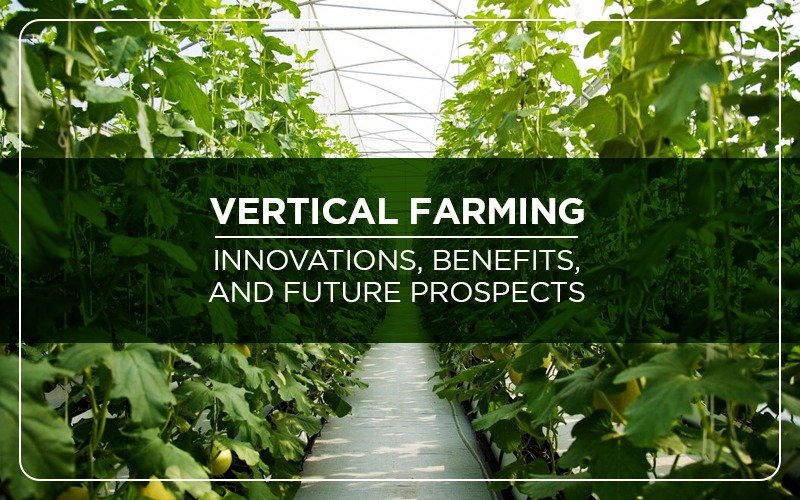
Vertical Farming: Innovations, Benefits, and Future Prospects
Posted on July 29, 2024
In recent years, the agricultural industry has witnessed a major shift towards innovative and sustainable farming methods. One such approach that has received much attention is vertical agriculture. The future of agriculture lies in exploring the benefits and challenges of vertical farming, as it offers a promising solution to the growing global demand for food while addressing concerns related to land scarcity , water use and climate change.
What is Vertical Farming?
Vertical farming is a revolutionary method of growing plants in vertically stacked tiers or structures, such as skyscrapers or ships’ tanks. It uses advanced technologies such as hydroponics, aeroponics, artificial lighting to create a controlled environment which mimics the optimum conditions for plant growth Efficient of traditional soil-based farming With tapurva, vertical farming increases crop yield, resource consumption and reduces.
Innovations Driving Vertical Farming
The success of vertical agriculture depends on technological innovations that improve resource efficiency and yield. One such innovation is hydroponics, a method of growing plants without soil, in which nutrient-rich water is delivered directly to plant roots. This method eliminates the need for land expansion and significantly reduces water consumption compared to conventional agriculture.
Aeroponics represents a new development in vertical farming, where plant roots are suspended in the air and periodically fertilized with solution This method allows for rapid growth and can consume surroundings precisely on our changing surroundings such as temperature, to ensure optimal growing conditions throughout the year
Additionally, the integration of LED lighting systems to suit specific plant needs has revolutionized indoor farming by enabling farmers to optimize light range, intensity and duration so it doesn’t seem to photosynthetic efficiency not only increases but also reduces energy consumption and operating costs.
Benefits of Vertical Farming
Vertical farming is a highly efficient way of growing crops and producing food. It has a number of benefits and holds great potential for the future.
- Land use efficiency: Agricultural production represents an intensive use of land. By sowing horizontally rather than horizontally, more crops can be grown in the same area. This increases the yield of the crop. This is especially important in densely populated areas where fertile land is scarce.
- Water conservation: Vertical agriculture incorporates techniques such as hydroponics, aeroponics and aquaponics. All of these methods use less water because the water contains more nutrients and minerals. This is especially useful in countries where water scarcity is an emerging problem.
- Reduced use of pesticides: Since this farming is done indoors, the use of pesticides is minimal. In jalaponics, for example, plants use fish waste to produce nutrients and minerals.
- Year-round production: Vertical cultivation is carried out in closed enclosures with temperature, water, light and humidity controlled. The entire climate is controlled by sophisticated techniques and the farm is able to grow crops all year round.
- Reducing air emissions: Vertical farming is done indoors. This reduces the distance between farms and consumers. This further reduces vehicle emissions and reduces the potential for damage.
Future of Vertical Farming
Here is the future of vertical farming that could be very important in the agricultural economy:
- Vertical agriculture maximizes space by growing crops in stacked terraces, making it suitable for urban areas with limited land. This is especially important as urbanization increases.
- Indoor vertical farming allows for precise control over environmental factors such as light, temperature and water. It uses resources more efficiently, reduces water consumption and reduces the use of pesticides
- Continuous technological advances in automation, artificial intelligence and precision farming are increasing the efficiency and productivity of the indoor vertical farm sector
- Vertical farms can be placed in a circular economy, where wastes from one process are used as inputs for another. For example, organic waste can be converted into compost or energy, creating a sustainable, closed system.
Conclusion
In conclusion, vertical farming appears as a good solution to overcome the major challenges faced by conventional agriculture, with scarcity of land, depletion of water, climate change sitting new technologies that hydroponics, aeroponics and LED lighting improve inputs and significantly increase yields among others
The advantages of vertical agriculture, with improved crop yields, use of fertile land, reduced water use, climate control and year-round construction come into play as a sustainable and resilient opportunity for traditional agricultural practices.
Looking ahead, the future of vertical agriculture holds great promise, especially in urban areas where land is limited. Continuous advances in automation, artificial intelligence and precision farming are poised to further enhance the efficiency and productivity of vertical farm operations Furthermore, the integration of vertical farms into the circular economy makes it possible sustainable closed-loop structures to minimize waste and maximize use of useful resources
Overall, vertical farming represents a important component of the rural panorama of the future, offering a course in the direction of meals protection, environmental sustainability, and resilience within the face of evolving international challenges. As studies and development efforts continue to pressure innovation in this discipline, vertical farming is poised to play a pivotal position in shaping the future of food production and distribution.
